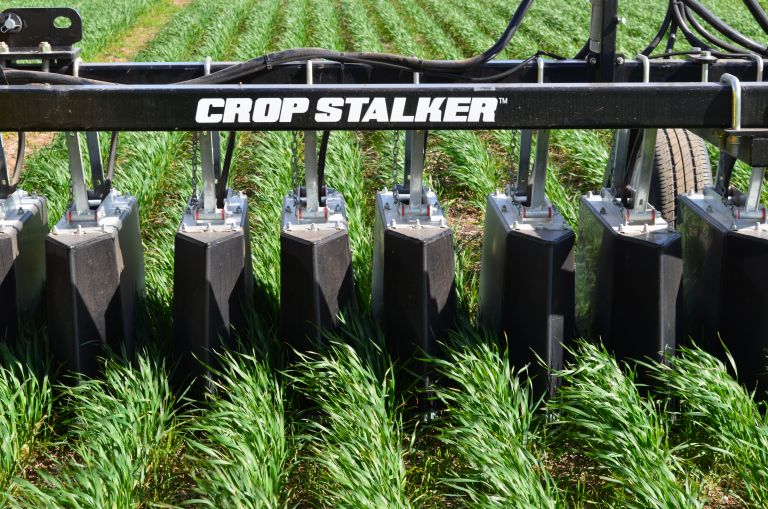Spray application manual
24 February 2025
Module 19: Shielded sprayers
19.7 Practical considerations
Published 24 January 2025 | Last updated 20 January 2025
As crop row spacing becomes narrower, and the crop canopy increases in size, the use of shielded sprayers in the inter-row space becomes more challenging. To apply products as an even band below the shield, the shield must be able to maintain its position relative to the plant row.
Factors that will influence the ability of the machine to maintain the position of the shield can include:
accuracy and repeatability of the guidance system and auto-steer functions;
matching the widths of the wheel centres for all implements;
the traffic system used on-farm and the condition of wheel tracks;
the use of efficient crop separators; and
the use of self-aligning tool bars (relative to the crop row).
Find out more
For more information on these topics, refer go to Module 12: GPS systems and Module 22: Integration of the sprayer with other farm equipment
Self aligning tool bars
The use of shielded sprayers in narrow crop row widths may require the ability to adjust the tool bar in relation to the crop row, particularly as the crop increases in size. There are toolbars, such as Robocrop®,which uses sensors to detect the crop row, and can adjust the position of the tool bar to keep implements in position in relation to the crop row.
Garford Robocrop InRow Weeder
6 January 20255 row Robocrop InRow Weeder from Garford Farm Machinery
Bill Gordon: I'm here with David Gooden, a grower from Lockhart, and we're just going to have a quick chat about some of the decisions he went through when purchasing a new spray rig. So, David, with this machine, what are some of the things you considered when you were buying it, and what were some of the most important factors for you?
David Gooden: Well, the key decision was trying to buy something for the future. We wanted something with a bit of ground clearance so we could do something later in-crop. We wanted something that would give us the ability to apply high water rates, have different rates over a range of speeds, and over a range of droplet sizes, and finally, good service and backup. We wanted to make sure we had someone who was able to do that.
Bill Gordon: So the spray system that you went with on this machine, what's it fitted with?
David Gooden: It's fitted with 3TS rapid-fire recirculation. We spaced our nozzles at 25 centimeters spacing to allow better coverage. The important thing with rapid-fire recirculation is that it allows us to apply chemicals over a large spread range and with different water rates. It also allows us to recirculate our chemical before we get to the field, so we're not having to charge up the lines before we start operating, before we start a paddock.
Bill Gordon: Any other functions or features on it that, when you were weighing up your decisions, you thought, "Oh, that's a good idea, I like that"?
David Gooden: Fuel use was a consideration, overall fuel use. So the machine we've got is a two-wheel drive, direct-drive machine, automatic, so the fuel use is quite low. The consumption is low. We wanted good service and good backup, so we wanted to deal with someone who knows about the whole system and can fix the problems when they occur.
Bill Gordon: When you purchased this machine, how wide did you end up going with the boom?
David Gooden: It's a 41-meter boom, and it matches with our controlled traffic system, so in multiples of 13.5 meters. We have a little bit of overlap.
Bill Gordon: Do you think that's an important thing for other people to consider when they're buying machines, how that sort of fits into the farming system and all the other equipment?
David Gooden: Absolutely. When going to controlled traffic, matching the sprayer is an important part of matching machinery.
Bill Gordon: So with this machine, how long do you reckon you'll keep it before you change it?
David Gooden: Maybe six years, say three or four thousand hours roughly.
Bill Gordon: So it seems to me that you spent a lot of time doing research and doing a bit of homework before you actually bought this machine, David.
David Gooden: That's right, yeah. We put a lot of work into trying to come up with the system that suited our operation and our needs and requirements to make it more efficient and effective when we go out and spray.
Bill Gordon: I think the take-home message for all growers is to do your homework and a bit of research about what sort of machine is going to suit your farming system. Think about the factors, some of the things that David talked about, and obviously service, speed range, volume, and how it fits into the future—into the farming system. They're really important. So it means that the machine that suits David may not be the same machine that's suitable for your farm.
Integrating target-selectable sprayers under shields
There are currently shielded sprayers that have integrated a WeedSeeker® system under the shields, for selectively targeting weeds in the inter-row.
The choice of target-selectable systems is limited by the required height of the sensor above the target. The WeedSeeker® sensors can operate at about 0.65 metres above the target, and have been fitted to commercially available shielded sprayers.
A Crop Stalker™ shielded sprayer, capable of being fitted with WeedSeeker® units under the shield

